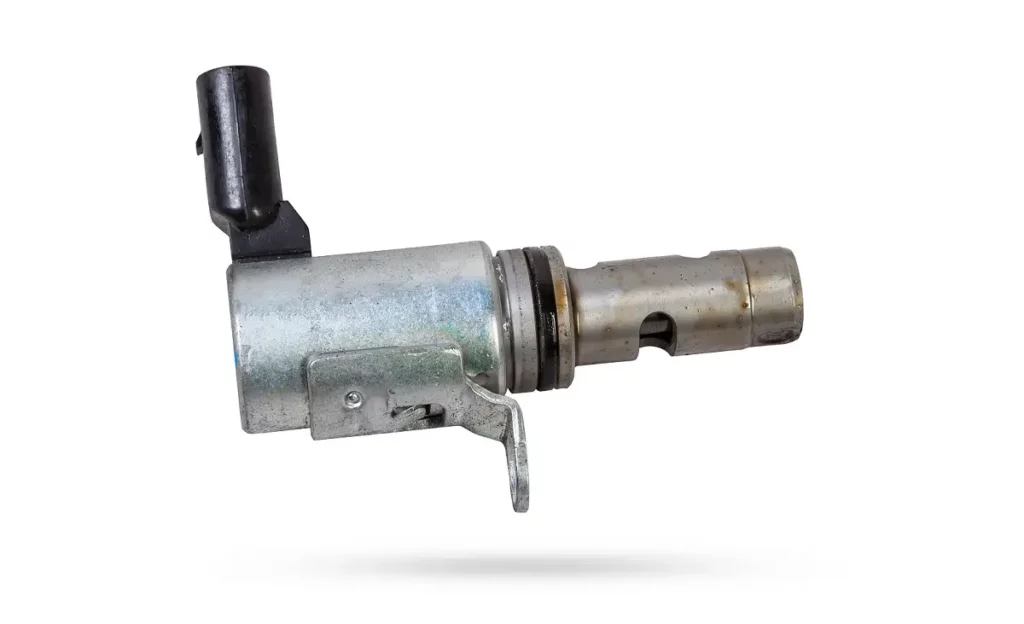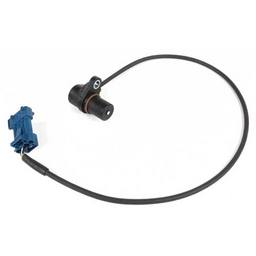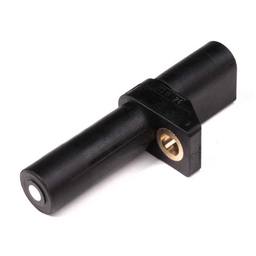The inner workings of a modern car engine are a fascinating marvel of engineering, and one crucial component that plays a vital role in its smooth operation is the crankshaft position sensor (CPS). Have you ever wondered how your engine knows precisely when to ignite the fuel and maintain optimal timing? That’s where the crankshaft position sensor comes into play. In this guide, we will delve into the world of CPS, exploring its purpose and functionality.
The CPS, as the name suggests, monitors the position and rotational speed of the crankshaft, a vital component in the engine’s internal combustion process. Join us as we unravel the mysteries of the crankshaft position sensor, shedding light on its significance in modern engine systems, common symptoms of failure, diagnostic methods, and essential maintenance practices. Let’s dive in and explore the wonders of this small yet mighty sensor.

Get a quality replacement crankshaft position sensor for your vehicle!
Understanding the Crankshaft Position Sensor
The crankshaft position sensor, commonly referred to as CPS, is a vital component found in modern internal combustion engines. Its primary function is to monitor the position and rotational speed of the crankshaft, which is responsible for converting the linear motion of pistons into rotational motion. By providing accurate data on the crankshaft’s position, the CPS plays a crucial role in the engine’s ignition timing and fuel injection.
In terms of location, the CPS is typically situated near the crankshaft or the flywheel, allowing it to detect the crankshaft’s movement directly. There are different types of CPS used in various engine designs, including magnetic, Hall effect, and optical sensors. Each type operates on different principles but serves the same purpose of measuring the crankshaft’s position accurately. In that sense, a crankshaft position sensor from an Audi may not work on the same principle as the one on a SAAB.
The CPS works in conjunction with the engine control unit (ECU) to ensure the precise timing of ignition and fuel injection. By continuously monitoring the crankshaft’s position, the sensor provides real-time data to the ECU, allowing it to make adjustments and optimize engine performance. This information is crucial for achieving efficient combustion, improving fuel efficiency, reducing emissions, and maximizing power output.
Understanding the fundamentals of the crankshaft position sensor is essential for diagnosing and resolving potential issues that may arise. In the next section, we will explore how the CPS operates and the key components involved in its functioning.
How Does a Crankshaft Position Sensor Work?
The operation of a crankshaft position sensor (CPS) involves a combination of precision engineering and advanced technology. Although different types of CPS exist, they all serve the same purpose of accurately detecting the position and rotational speed of the crankshaft in an internal combustion engine. Let’s explore how a typical CPS works:
- Sensor Location: The CPS is strategically positioned near the crankshaft or the flywheel, where it can sense the crankshaft’s movement directly. This allows it to obtain precise data on the position and rotational speed.
- Sensor Principle: CPS utilizes various principles to detect the crankshaft’s movement. One common type is the magnetic sensor, which consists of a magnet and a coil. As the crankshaft rotates, the magnet generates a magnetic field that induces a voltage in the coil. The voltage produced is proportional to the speed and position of the crankshaft.
- Signal Generation: The CPS generates a signal based on the magnetic field or other sensing principles, such as the Hall effect or optical detection. This signal is then transmitted to the engine control unit (ECU) for processing.
- ECU Communication: The ECU receives the signal from the CPS and interprets it to determine the crankshaft’s exact position. This information is crucial for the ECU to adjust the engine’s ignition timing and fuel injection accordingly.
- Timing Adjustment: With the data received from the CPS, the ECU can precisely time the ignition spark and control the fuel injection duration, optimizing the combustion process. This ensures efficient engine performance, fuel economy, and reduced emissions.
The accurate detection and transmission of crankshaft position data by the CPS enable the engine to operate smoothly and reliably. In the next section, we will explore the significance of the crankshaft position sensor in engine management systems.
Significance of the Crankshaft Position Sensor
The crankshaft position sensor (CPS) holds significant importance in modern engine management systems. Its role extends beyond merely detecting the position and rotational speed of the crankshaft. Let’s delve into the significance of the CPS in engine operation:
Ignition Timing Control
The CPS plays a crucial role in determining the precise timing of ignition events. By accurately detecting the crankshaft’s position, the CPS provides the engine control unit (ECU) with essential data to determine the optimal moment to ignite the air-fuel mixture in each cylinder. This precise ignition timing ensures efficient combustion, maximizes power output, and minimizes the risk of engine knock.
Fuel Injection Control
The CPS also contributes to precise fuel injection control. By continuously monitoring the crankshaft’s position, the CPS provides real-time data to the ECU, enabling it to precisely time the injection of fuel into each cylinder. This ensures optimal fuel-air mixture ratios, improving fuel efficiency, reducing emissions, and enhancing overall engine performance.
Engine Synchronization
The CPS aids in synchronizing various engine components. By accurately detecting the crankshaft’s rotational position, the CPS allows the ECU to coordinate the operation of other engine components, such as the camshaft and fuel injectors. This synchronization ensures the smooth and coordinated functioning of the engine’s mechanical and electrical systems.
Diagnostic Capabilities
In addition to its primary role in engine performance, the CPS also provides valuable diagnostic capabilities. If the CPS malfunctions or fails, it can cause a range of issues, including misfires, rough idling, or difficulty starting the engine. The ECU can detect abnormalities in the CPS signal, triggering diagnostic trouble codes (DTCs) that aid technicians in diagnosing and repairing potential problems.
Safety Features
Some engine management systems utilize CPS data for safety features such as engine speed limiting and traction control. The CPS data helps the ECU maintain safe operating conditions and prevent excessive engine speeds that could lead to mechanical failures or loss of control.
Symptoms of a Failing Crankshaft Position Sensor
A failing crankshaft position sensor (CPS) can have a significant impact on engine performance and drivability. It’s important to be aware of the common symptoms that indicate a potential issue with the CPS. Here are some telltale signs of a failing CPS:
- Engine Stalling or Intermittent Starting Issues: A malfunctioning CPS may cause the engine to stall unexpectedly or have difficulty starting. This can occur when the sensor fails to provide accurate data on the crankshaft’s position, leading to improper fuel injection or ignition timing.
- Rough Idling: If the CPS is failing, it can result in an unstable or rough idle. You may notice the engine running unevenly, experiencing fluctuations in RPM (revolutions per minute), or even stalling while at a standstill.
- Decreased Engine Performance: A faulty CPS can lead to a decrease in engine power and overall performance. The engine may feel sluggish, lacking acceleration and responsiveness, as the ECU struggles to maintain proper timing and fuel delivery without accurate crankshaft position data.
- Misfires and Hesitation: A failing CPS can cause misfires, where one or more cylinders fail to ignite properly. This can result in engine hesitation, reduced power output, and an overall decrease in smoothness during acceleration.
- Check Engine Light: In many cases, a malfunctioning CPS will trigger the check engine light (CEL) on the vehicle’s dashboard. The ECU detects irregularities in the CPS signal and stores diagnostic trouble codes (DTCs) related to the issue.
It’s important to note that while these symptoms are commonly associated with a failing CPS, they can also indicate other engine-related problems. If you experience any of these symptoms, it is advisable to consult a qualified mechanic or use diagnostic tools to accurately diagnose the issue.
Crankshaft Position Sensor Fault Codes

When a crankshaft position sensor (CPS) malfunctions or fails, it can trigger specific diagnostic fault codes (DTCs) that indicate a problem with the sensor. These codes may vary slightly depending on the vehicle make and model, as well as the specific engine management system. Here are some common DTCs associated with a faulty CPS:
P0335 – Crankshaft Position Sensor “A” Circuit Malfunction: This code indicates a general problem with the circuit of the crankshaft position sensor. It can be caused by issues such as wiring problems, sensor failure, or a faulty connection.
P0336 – Crankshaft Position Sensor “A” Circuit Range/Performance: This DTC suggests that the signal received from the CPS is out of the expected range or is not performing as expected. It may indicate issues with the sensor’s output or an inconsistent signal.
P0337 – Crankshaft Position Sensor “A” Circuit Low Input: This code indicates that the signal from the CPS is registering a voltage below the expected range. It may be caused by wiring issues, a faulty sensor, or a poor connection.
P0338 – Crankshaft Position Sensor “A” Circuit High Input: The opposite of the previous code, this DTC suggests that the signal from the CPS is registering a voltage above the expected range. Similar to P0337, it can be caused by wiring issues, a faulty sensor, or a poor connection.
Diagnosing and Replacing a Crankshaft Position Sensor
Diagnosing and replacing a crankshaft position sensor (CPS) requires careful attention and proper procedure. Here’s a step-by-step guide to help you diagnose and replace a faulty CPS:
Diagnostic Tools: Start by using an OBD-II scanner to retrieve any diagnostic trouble codes (DTCs) related to the CPS. These codes can provide valuable information about the specific issue with the sensor.
Visual Inspection: Inspect the wiring harness and connector associated with the CPS for any signs of damage, corrosion, or loose connections. Ensure that the sensor is securely fastened in its designated location.
Testing the CPS Signal: Use a digital multimeter or an oscilloscope to test the CPS signal. Follow the manufacturer’s specifications to measure the voltage, resistance, or waveform pattern generated by the sensor. Compare the readings to the recommended values to determine if the CPS is functioning correctly.
Check for Proper Grounding: A faulty ground connection can also cause issues with the CPS. Ensure that the CPS is properly grounded and that there are no loose or corroded connections.
Test the Sensor’s Response: With the engine running, observe the sensor’s response to engine RPM changes. The CPS signal should correspond to the crankshaft’s rotational speed and position. Any erratic or inconsistent readings may indicate a failing sensor.
Replacement Procedure: If the CPS is determined to be faulty, proceed with replacing it. Refer to the vehicle’s service manual or manufacturer guidelines for the specific steps involved. Typically, this involves disconnecting the electrical connector, removing any mounting bolts, and carefully pulling out the old sensor. Install the new CPS following the reverse procedure.
Clearing DTCs: After replacing the CPS, use the OBD-II scanner to clear any stored DTCs. This will reset the check engine light and allow the ECU to start fresh with the new sensor.
It is important to note that the exact diagnostic and replacement procedure may vary depending on the vehicle’s make and model.
Get Quality Crankshaft Position Sensors at eEuroparts.com
The crankshaft position sensor (CPS) is an essential component in modern engine systems, responsible for accurate ignition timing, fuel injection control, and engine synchronization. Understanding its purpose, operation, and significance is vital for maintaining optimal engine performance and diagnosing potential issues.
As for parts, you’re in the right place. Here at eEuroparts.com, we offer a wide range of crankshaft position sensors made by some of the most reputable brands in the industry. Check out our catalog and find a crankshaft position sensor that will give your engine its reliability back!





